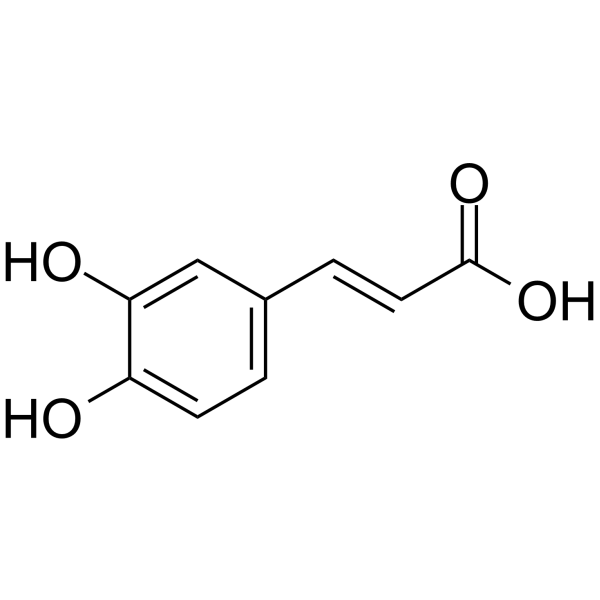上海金畔生物科技有限公司为生命科学和医药研发人员提供生物活性分子抑制剂、激动剂、特异性抑制剂、化合物库、重组蛋白,专注于信号通路和疾病研究领域。
Caffeic acid (Synonyms: 咖啡酸) 纯度: 98.71%
Caffeic acid 是 TRPV1 离子通道和 5-脂氧合酶 (5-LO) 的抑制剂。

Caffeic acid Chemical Structure
CAS No. : 331-39-5
| 规格 | 价格 | 是否有货 | 数量 |
|---|---|---|---|
| Free Sample (0.1-0.5 mg) | Apply now | ||
| 10 mM * 1 mL in DMSO | ¥550 | In-stock | |
| 100 mg | ¥500 | In-stock | |
| 5 g | ¥850 | In-stock | |
| 10 g | 询价 | ||
| 50 g | 询价 |
* Please select Quantity before adding items.
Caffeic acid 相关产品
•相关化合物库:
- Natural Product Library Plus
- Drug Repurposing Compound Library Plus
- FDA-Approved Drug Library Plus
- FDA-Approved Drug Library Mini
- Bioactive Compound Library Plus
- Immunology/Inflammation Compound Library
- Membrane Transporter/Ion Channel Compound Library
- Metabolism/Protease Compound Library
- Neuronal Signaling Compound Library
- Natural Product Library
- FDA-Approved Drug Library
- Anti-Cancer Compound Library
- Human Endogenous Metabolite Compound Library
- Drug Repurposing Compound Library
- Ferroptosis Compound Library
- Anti-COVID-19 Compound Library
- NMPA-Approved Drug Library
- Medicine Food Homology Compound Library
- Phenols Library
- Orally Active Compound Library
- Traditional Chinese Medicine Monomer Library
- FDA Approved & Pharmacopeial Drug Library
- Lipid Metabolism Compound Library
- Food-Sourced Compound Library
- Mechanoreceptors Compound Library
- Tumorigenesis Related Compound Library
| 生物活性 |
Caffeic acid is an inhibitor of both TRPV1 ion channel and 5-Lipoxygenase (5-LO). |
||||||||||||||||
|---|---|---|---|---|---|---|---|---|---|---|---|---|---|---|---|---|---|
| IC50 & Target |
|
||||||||||||||||
| 体外研究 (In Vitro) |
Caffeic acid has inhibitory effects on histamine-induced responses and the inhibitory effect of Caffeic acid is gradually increased when the concentration used for pretreatment is increased from 0.1 to 1 mM, similar to typical dose-dependent responses. Pretreatment of HEK293T-TRPV1 cells with 1 mM Caffeic acid results in significant inhibition of capsaicin-induced responses. When lower concentration of Caffeic acid is used, the inhibitory effect for capsaicin-induced responses is less evident. Calcium imaging experiments show that Caffeic acid incubation results in significant inhibition in histamine-sensitive dorsal root ganglion (DRG) neurons. Pretreatment with Caffeic acid (1 mM) results in a significant decrease in the percentage of responsive DRG neurons to histamine application from 12.5% to 2.1%. Pretreatment with 1 mM Caffeic acid dramatically blocks the allylisothiocyanate (AITC)-induced intracellular calcium increase in TRPA1-expressing cells. Caffeic acid is also able to block the AITC-induced activation of TRPA1[1]. 上海金畔生物科技有限公司 has not independently confirmed the accuracy of these methods. They are for reference only. |
||||||||||||||||
| 体内研究 (In Vivo) |
Mice pretreated with Caffeic acid (500 mg/kg) exhibit significantly less histamine-induced scratching (30.50±10.87 bouts/1 h, n=6). It is further found that the lower dose of Caffeic acid (100 mg/kg) is not significantly effective in terms of anti-scratching effects in histamine-induced scratching, although there appears to be a tendency of reduction (49.40±12.35 bouts/1 h, n=5). The chloroquine induced scratching is significantly inhibited by pretreatment with 500 mg/kg of Caffeic acid (161.6±31.42 bouts/1 h, n=5)[1].Caffeic acid significantly reduces the expression of 5-LO mRNA (P<0.01) dose-dependently in hippocampus. Compare with the ischemia-reperfusion (I/R) non-treated group, 5-LO protein expression is significantly reduced in the I/R-Caffeic acid group (P<0.05 or P<0.01), especially in the I/R-Caffeic acid group (50 mg/kg). Compare with the I/R non-treated group, the latency to find platform is significantly shortened in low- and high-dose Caffeic acid groups, the shortened platform latency is most evident in the I/R- Caffeic acid group (50 mg/kg) (P<0.01). In the low-dose Caffeic acid group, cell injury is still marked, the pyknosis ratio is (63.6±2.8)%, whereas in the high-dose Caffeic acid group, hippocampal neuron karyopyknosis is significantly reduced and the pyknosis ratio is (13.3±3.0)%[2]. 上海金畔生物科技有限公司 has not independently confirmed the accuracy of these methods. They are for reference only. |
||||||||||||||||
| Clinical Trial |
|
||||||||||||||||
| 分子量 |
180.16 |
||||||||||||||||
| Formula |
C9H8O4 |
||||||||||||||||
| CAS 号 |
331-39-5 |
||||||||||||||||
| 中文名称 |
咖啡酸 |
||||||||||||||||
| 运输条件 |
Room temperature in continental US; may vary elsewhere. |
||||||||||||||||
| 储存方式 |
|
||||||||||||||||
| 溶解性数据 |
In Vitro:
DMSO : 100 mg/mL (555.06 mM; Need ultrasonic) H2O : < 0.1 mg/mL (insoluble) 配制储备液
*
请根据产品在不同溶剂中的溶解度选择合适的溶剂配制储备液;一旦配成溶液,请分装保存,避免反复冻融造成的产品失效。 In Vivo:
请根据您的实验动物和给药方式选择适当的溶解方案。以下溶解方案都请先按照 In Vitro 方式配制澄清的储备液,再依次添加助溶剂: ——为保证实验结果的可靠性,澄清的储备液可以根据储存条件,适当保存;体内实验的工作液,建议您现用现配,当天使用; 以下溶剂前显示的百
|
||||||||||||||||
| 参考文献 |
|
| Cell Assay [1] |
To determine cell viability, MTT assay is performed. HEK293T cells are cultured in 96-well plate at 37°C, a day before so that the confluence of cell is 85 to 90% on the actual day of the experiment. On the day of the experiment the cells are treated with different concentration of Caffeic acid for 10 min. Control cells are treated only with media. After removing supernatant and washing with PBS, MTT reagent (5 mg/mL) is added directly to fresh media. Cells are then incubated at 37°C for additional 4 h followed by draining of the media and overnight storage in dark condition. The next day, DMSO is added to each well and mixed in shaker for 10 min after which plate is read using microplate recorder at 490 nm with a reference wavelength of 620 nm. The relative cell viability (%) is expressed as a percentage relative to the untreated control cells[1]. 上海金畔生物科技有限公司 has not independently confirmed the accuracy of these methods. They are for reference only. |
|---|---|
| Animal Administration [2] |
Rats are divided into five groups: the sham group (n=9), ischemia-reperfusion (I/R) non-treated group (n=9), I/R-Caffeic acid group (10 mg/kg) (n=9), I/R-Caffeic acid group (30 mg/kg) (n=9) and I/R- Caffeic acid group (50 mg/kg) (n=9). In I/R-Caffeic acid groups, the rats are administrated Caffeic acid at 10, 30, 50 mg/kg (prepared with 0.3% sodium carboxymethyl cellulose) by intraperitoneal injection at 30 min prior to ischemia. The sham group and I/R group are treated with an equal volume of 0.3% sodium carboxymethyl cellulose[2]. 上海金畔生物科技有限公司 has not independently confirmed the accuracy of these methods. They are for reference only. |
| 参考文献 |
|
所有产品仅用作科学研究或药证申报,我们不为任何个人用途提供产品和服务
